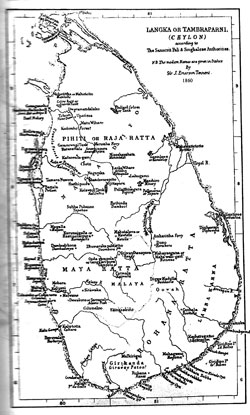Each country, unless it is far too small, is divided into geographical units particularly for administrative purposes. From the earliest times Sri Lanka too had maintained a tradition of dividing the island into three main divisions with one monarch ruling the country from the capital.
According to historical records, Vijaya reigned for thirty eight years from Tambapanni, the place he set up as his capital. Realising that there was no heir to succeed him since he did not have any children, he sent word to his brother Sumitta to come over and become king. However, since Sumitta had already been crowned king in his own country he did not want to leave. Instead he sent his youngest son Panduvasudeva to
Sri Lanka. By the time he arrived Vijaya had passed away and his chief advisor, the 'purohita' Brahmin named Upatissa was administering the kingdom from Upatissagama, the settlement named after him.
 Panduvasudeva continued to rule from Upatissagama. The first divisions of the country for administrative purposes are seen when he sent out several of his
followers who had accompanied him to form settlements and develop them. Among them were six brothers of his queen Bhaddakaccana. One of them – Anuradha called his
settlement Anuradhagama which was soon to be the first real capital of ancient Sri Lanka – Anuradhapura, the city of Anuradha. Among other better known settlements established at that time were Vijitagama named after Vijita, and Rohana and Dighayu. Panduvasudeva continued to rule from Upatissagama. The first divisions of the country for administrative purposes are seen when he sent out several of his
followers who had accompanied him to form settlements and develop them. Among them were six brothers of his queen Bhaddakaccana. One of them – Anuradha called his
settlement Anuradhagama which was soon to be the first real capital of ancient Sri Lanka – Anuradhapura, the city of Anuradha. Among other better known settlements established at that time were Vijitagama named after Vijita, and Rohana and Dighayu.
The development of the capital city of Anuradhapura was under King Pandukabhaya who gradually streamlined the administration of the city and the suburbs – the latter called the four 'gate villages'. The administration of the city was under an official known as 'nagaraguttika' – equivalent to the present mayor in a municipality.
Ten years after ascending the throne, Pandukabhaya is said to have established the village boundaries right round the country.
By the 12th century historical records refer to 'Tri-simhala-rajaya' establishing the fact that there were three principalities or three main
territorial divisions in Sri Lanka. They were Rajarata, Rohana-desa and Malaya-desa.
Rajarata, as the name suggests, was the land of the kings. It was the kingdom of the monarch who ruled from Anuradhapura. The fact that King Dutugemunu is credited with the unification of the entire country means that there were territorial divisions. Rajarata itself had been divided into four divisions on the basis of the cardinal directions taking Anuradhapura as the focal point. The most important of these divisions was Dakkhinadesa, the southern division which was the principality of the heir to the throne.
Rohana-desa or Ruhuna comprised all the area to east of the Mahaveli ganga together with the
present Batticaloa, Monaragala, Hambantota, Matara and Galle districts. Its capital was Mahagama (Tissamaharama). The Mahaveli ganga served as the boundary between Rajarata and Ruhuna. The rulers of Ruhuna were generally princes who were either independent or semi-independent of the Anuradhapura king.
When there were foreign invasions of the kingdom of Anuradhapura,
resistance always came from Ruhuna. The best example, of course, was Dutugemunu who rallied his forces to attack Elara, the Tamil king who was ruling from Anuradhapura for several decades.
Malaya extended over the
mountain region and its foothills and was ruled by a junior prince designated as the Malayaraja. Gems and spices were the main products in Malaya while agricultural activity was very limited.
Towards the end of the 12th
century, the name Rajarata changed to Pihitirata. Dakkhinadesa and Malaya were amalgamated to form Mayarata – the land of the 'maaya' or crown prince. |

 Panduvasudeva continued to rule from Upatissagama. The first divisions of the country for administrative purposes are seen when he sent out several of his
followers who had accompanied him to form settlements and develop them. Among them were six brothers of his queen Bhaddakaccana. One of them – Anuradha called his
settlement Anuradhagama which was soon to be the first real capital of ancient Sri Lanka – Anuradhapura, the city of Anuradha. Among other better known settlements established at that time were Vijitagama named after Vijita, and Rohana and Dighayu.
Panduvasudeva continued to rule from Upatissagama. The first divisions of the country for administrative purposes are seen when he sent out several of his
followers who had accompanied him to form settlements and develop them. Among them were six brothers of his queen Bhaddakaccana. One of them – Anuradha called his
settlement Anuradhagama which was soon to be the first real capital of ancient Sri Lanka – Anuradhapura, the city of Anuradha. Among other better known settlements established at that time were Vijitagama named after Vijita, and Rohana and Dighayu. 